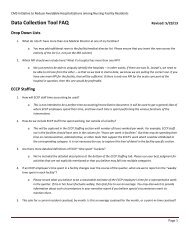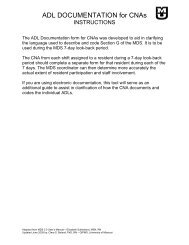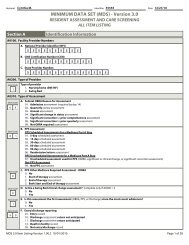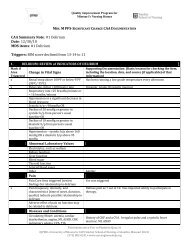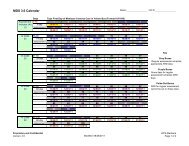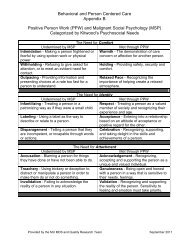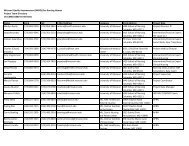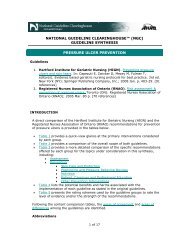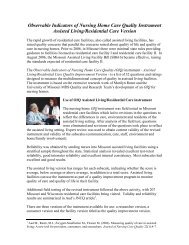Data Retrieval Worksheet - Nursing Home Help
Data Retrieval Worksheet - Nursing Home Help
Data Retrieval Worksheet - Nursing Home Help
Create successful ePaper yourself
Turn your PDF publications into a flip-book with our unique Google optimized e-Paper software.
a. Person’s daily activities areexamined for periods of high orlow stimulation and activity thatare sustained for 1½ hours orlonger without change.b. Person’s daily schedule isreconfigured to adjust periods ofhigh/low activity that are causingthe imbalance, and meet theneeds of the individual.I, O 3. Meaningful Human Interaction:Many social-psychological theories ofcare for the person with dementiaindicate that social neglect isassociated with cognitive, social, andfunctional decline.a. Person’s daily activities areexamined for meaningful one-toonehuman interaction.b. If person is not receiving 10-20minutes twice daily of positiveone-to-one personal interaction,formal interaction engagementactivities are supplied r/t personalpreference/need.c. Individual may be “targeted” bystaff for interaction during periodsthey are at risk for no or littleengagement.III. Assessment of Comfort Asks the question, “What provides comfort to this person?”I, O, R, E 1. Comfort Assessment: Having indepth knowledge of the person’sbackground, spirituality, interests,taste is essential. Some examples:a. <strong>Help</strong>ing/enabling someone topray.b. Assisting /enabling someone withbooks, pictures, and objects,religious or otherwise, meaningfulto that person.c. Assessing/acknowledging aperson’s need for human touch,appropriate affection.d. Assisting with music or activitiesthat may have personal meaninge. Providing favorite foods, drinks,scents, remembrances from aperson’s past.IV. Pain Medication as an Assessment StepI, O, R 1. Analgesic Trial: Pain and discomfortProvided by the MU MDS and Quality Research Team September 2011
are not always evident in the personwith dementia, even after physicalexam. Evidence supports the use ofpain medication as a behavioralassessment step.a. Trial of ordered pain medicationmayneed more than one dose.b. If an introduction of or changes topain medications and treatmentswere made in the physicalassessment step and pain is stilla potential, adjustments/changes/additions may be necessary.V. Examination of Remaining Psychosocial NeedsAsks the question, “Does this person have unmet psychosocial needs?”Meeting psychosocial needs is essential to enabling quality of life for the person withdementia.I, O, E 1. Assessment of RemainingPsychosocial Needs Deficits:a. The individual may have physicaland affective needs met but maynot be back to baseline. Considerthat most physical needs have apsychosocial component (Pleasesee Appendix A and B, Kitwood’ssigns of well-being and ill-beingand Positive Person Work skillsfor enabling Personhood).b. What deficits remain in thisperson’s needs for: Occupation-Self agency inADLs; meaningful activity Identity-Our sense of who weare along with self-worth Attachment-Connections withfamily, friends, surroundings Inclusion-Belonging tosomething greater than justourselves Comfort-Provision of warmthand closenessVI. Re-evaluation of Assessment ProcessR,O,IAsks the question, “Do the person’s needs continue to be met in all assessment areas?”1. Interventions chosen are related toassessment findings.2. Findings and interventions are reevaluatedat least quarterly with RAIprocess.3. Findings and interventions are reevaluatedwith each change inbehavior.Provided by the MU MDS and Quality Research Team September 2011
4. Re-assessment is completed if anychanges occur.VII. Documentation of Assessment ProcessR, O,I 1. Documentation of all areas ofassessment process completed arefound in the record2. Documentation of findings are clearand concise3. The care plan reflects theassessment findings and relatedinterventions4. There is evidence that the intendedcare is being carried out5. There is evidence in the record/careplan that the assessment findingsand interventions are re-evaluated atleast quarterly6. There is evidence in the record/careplan that the assessment findingsand interventions are re-evaluatedwith onset of new behaviors orchange in behaviorsBrooker, D. 2007. Person-Centered Dementia Care: Making services better. Jessica Kingsley Publishers;London.Kovach, K, et al 2006. The serial trial intervention: an innovative approach to meeting needs of individualswith dementia. Journal of Gerontological <strong>Nursing</strong>, 32(4), 18-27.Kovach, K, Kelber, S, Simpson, M & Wells, T. 2006. Behaviors of nursing home residents with dementia:examining nurses response. Journal of Gerontological <strong>Nursing</strong>, 32(6), 13-21.Long, C. 2009. Palliative care for advanced dementia: approaches that work. Journal of Gerontological<strong>Nursing</strong>, 35(11), 19-24.Rasin, J. 2007. Knowing the resident with dementia: perspectives of assisted living facility caregivers.Journal of Gerontological <strong>Nursing</strong>, 33(9), 30-36.Specht, J, Taylor, R, & Bossen, A. 2009. Partnering for care: the evidence and the expert. Journal ofGerontological <strong>Nursing</strong>, 35(3), 16-22.Whall, A. & Kolanowski, A. (2004). The need-driven dementia-compromised behavior model: Aframework for understanding the behavioral symptoms of dementia. Aging & Mental Health, 8(2), 106-108.Provided by the MU MDS and Quality Research Team September 2011



